Strawberries
BackStrawberries are probably the most popular fruit in the world with their sweet juicy berries that are a good source of both vitamin B and C. They are easy to grow in garden beds, pots and hanging baskets making them perfect for even the smallest garden or balcony.
Strawberries are also a great way to get kids interested in gardening as they can reap the benefits of their toils in a few short months. If any manage to make it back to the kitchen try coating them in chocolate – yum!
There are many different strawberry varieties especially from online stockists (like The Diggers Club and Green Harvest). Choose varieties which suit your climate and that can extend your harvest time.
How To Grow Strawberries
Plants can be purchased as bare-rooted crowns in autumn and winter or as potted plants usually during the warmer months. If accepting plants or runners from friends be sure the plants are virus free before introducing them into your garden.
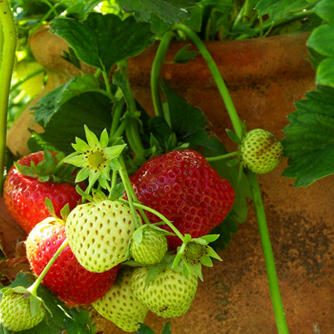
Strawberries in a pot
Choose a site in full sun with fertile, free-draining soil. Strawberries perform much better if well fed so dig in a generous amount of animal manure and compost and if possible let it rest for a week or two before planting. They also like their soil to be on the acidic side so you should test the pH. Adding the above organic materials will help acidify soil but depending on your pH reading you may also need to add sulphur.
Plant so that the strawberry crown sits just above ground level to provide good drainage and prevent crown rot. Mulch around the plants with straw or sugar cane mulch to reduce disease transfer and keep fruit clean as it develops.
Water in with a mixture of OCP eco-aminogro and OCP eco-seaweed to help plants settle in and develop roots faster. Ensure bare-rooted plants and runners are well watered until established.
Plants will flower during the warmer months of the year with fruit being ready to pick 3-6 weeks after that. Most varieties will produce multiple crops a year provided they are well fed and watered.
You may also see strawberry seed available and this will be for the alpine strawberry which produce small but extremely flavoursome berries. Sow seed in autumn or spring.
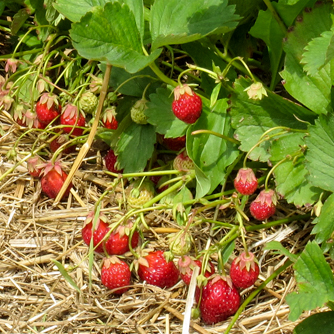
Strawberries kept clean by mulch
Fertilising Strawberries
Feed plants every 2-3 months with animal manure, compost or a Certified Organic pelletised organic fertiliser. In addition we recommend applying a solution of eco-seaweed and eco-aminogro every 2-3 weeks to keep plants vigorous, healthy and FRUITING.
Ongoing Strawberry Maintenance
Water plants early in the day so that leaves and fruit dry off quickly to help deter fungal diseases developing. Remove any dead or tatty leaves to improve airflow and again reduce disease problems.
Established plants will produce runners and these should be removed regularly to encourage energy to go into fruit production. Only keep runners if you wish to propagate new plants.
Strawberry plants often loose vigour after 2-3 years and you will find that the fruiting reduces. Sometimes this is because of the variety you are growing but often it is due to viral infections which are very common in strawberries. When this happens buy replacement virus-free plants and prepare a new strawberry patch in a different part of the garden.
However if the plants are just tired (and not virus infected) then dig up clumps in winter, remove all old leaves and split the crowns. Select a new site, add manure and compost to the bed and then replant only the strongest crowns. Another option is to leave the runners on the plants in late summer and let them take root. They can then be cut from the mother plant and transplanted into a new strawberry patch where they will quickly develop into crowns.
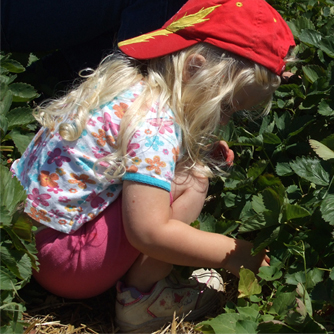
Kids love picking strawberries!
Pest and Disease Problems for Strawberries
Unfortunately we’re not the only ones who love strawberries with plenty of pests and diseases willing to attack them including:
- Aphids, mites and whitefly - look out for these sap suckers and use OCP eco-oil to control as required.
- Powdery mildew - control this common disease with sprays of OCP eco-fungicide.
- Other diseases - there are additional diseases which can attack strawberries. Regularly remove dead leaves and rotting fruit as a first step to avoid problems. We also recommend using with the spray mix listed below to keep plants super healthy and minimise disease problems.
- Snails and slugs - protect your fruit by applying OCP eco-shield pellets regularly around plants.
- Slaters - these scavengers often find the ripening fruit irresistible so sprinkle OCP eco-shield around to keep fruit protected. If possible keep the fruit from the touching the ground or mulch so there's less chance of slaters finding the fruit.
- Caterpillars - watch out for these very hungry pests and spray with OCP eco-caterpillar killer if they become a problem.
- Root-knot nematodes - poor performing plants, which wilt easily, could indicate the presence of parasitic nematodes. Dig up a plant and if the roots are lumpy and knotted up then unfortunately you've got nematodes. Treat the soil with OCP eco-nemguard.
- Birds, possums, rats and more - if larger creatures start eating the fruit then use fine netting to keep them excluded.
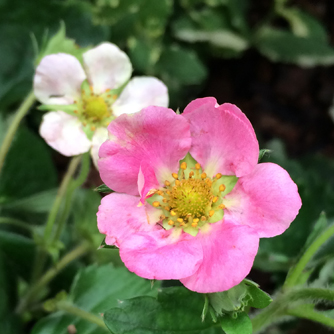
Uncommon pink flowering strawberry (usually they're white)
Strawberries are also susceptible to a range of viruses which can cause stunted growth, crinkled leaves, misshapen fruit and reduced vigour. Infected plants cannot be “fixed” so the focus is on prevention. Here are our prevention tips:
- Do not plant strawberries where tomatoes or potatoes have previously been growing for 2-3 year as they can share the same viruses
- Rotate the strawberry patch location every few years using fresh virus-free plants
- Control aphids regularly with OCP eco-oil as they can transmit viruses
While this all might sound a bit daunting there is an easy way to keep your plants happy and healthy and it’s our “secret recipe” spray. Mix the following products together:
eco-seaweed + eco-aminogro + eco-oil + eco-fungicide
Spray plants every 2 weeks with this solution to promote vigour and feed plants while controlling the common pest and disease problems. Be sure to make a fresh batch of spray each time. It really is that easy!
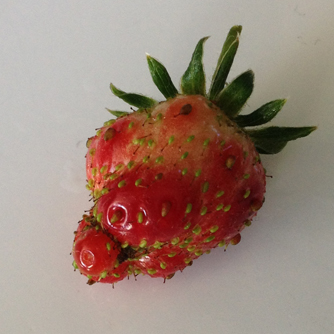
Misshapen fruit caused by insect attack when forming, poor pollination or due to a virus


